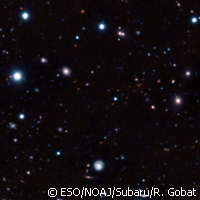Astronomers discover oldest ever remote galaxies cluster
EU-funded astronomers have discovered and measured the distance to the most remote and mature cluster of galaxies ever found. The study, published in the journal Astronomy and Physics, was supported in part by the UPGAL ('Understanding the physics of galaxy formation and evolution at high redshift') project, which has clinched almost EUR 940,000 under the Ideas Programme of the Seventh Framework Programme (FP7). Clusters of galaxies, the largest structures in the Universe held together by gravity, normally age over time. However, the cluster identified by the team of astronomers shows notable signs of maturity - a rarity for a galaxy cluster in the early Universe. Although even more distant clusters have been seen before, these have been in the process of formation and are not yet settled mature systems. The light from the galaxy cluster took so long to reach Earth that the astronomers viewed the galaxy cluster as it was when the Universe was about 3 billion years old, less than a quarter of its current age. The results also show that the galaxy cluster looks very similar to those that exist in the current Universe. Key characteristics which give away a galaxy cluster's age are the make-up of its stars and how it traps gas. The findings show that most of the galaxies in the cluster were made up of stars already around 1 billion years old, rather than forming stars. This makes the cluster mature and it can be classed as similar in form to the Milky Way or the Virgo Cluster. In addition, the cluster is giving off X-rays that must be coming from a very hot cloud of tenuous gas filling the space between the galaxies and concentrated towards the centre of the cluster. A cluster held together by its own gravity is another sign of maturity, as younger clusters have not yet had the time to trap hot gas in that way. 'These new results support the idea that mature clusters existed when the Universe was less than one quarter of its current age,' says Raphael Gobat, a researcher from Laboratoire AIM-Paris-Saclay in France. 'Such clusters are expected to be very rare according to current theory, and we have been very lucky to spot one.' To identify the cluster the researchers used a plethora of telescopes both on Earth and in space, such as the Very Large Telescope (VLT), located in the Atacama Desert, Chile and run by the European Southern Observatory (ESO). A curious patch of very faint red objects was first spotted with the Spitzer space telescope which is currently orbiting the Sun. 'We stumbled on this galaxy by chance: the structure caught our eyes as a clump of galaxies which appeared much redder and more concentrated than those in the surroundings,' says Emanuele Daddi, also from the Laboratoire AIM-Paris-Saclay. The distances to these mysterious objects were then measured with the VLT. Once the distances were established, the components of its galaxies were analysed using the NASA/ESA (European Space Agency) Hubble Space Telescope as well as telescopes on Earth. While it took several years of observations to confirm what the structure was, future X-ray observatories could routinely find and study similar clusters and unveil their structure in detail. If more galaxy clusters like this one were found there could be implications for the current widely accepted theory about how cosmic structures are formed, according to the team. 'This discovery has shown, for the first time, that old clusters were already present in the young Universe and that we are able to observe them,' says Dr Gobat. 'Only time will tell us what "old" and "young" really mean and what this implies in the broader context of cosmology.' The Ideas programme of FP7 is investigator-driven and aims to support activities in 'frontier research', carried out by individual teams competing at European level, within and across all fields of research. Projects are funded on the basis of proposals presented by researchers both from the private and public sectors on subjects of their choice and evaluated on the sole criterion of excellence, as judged by peer review.For more information, please visit: European Southern Observatory (ESO):http://www.eso.org European Space Agency (ESA):http://www.esa.int Astronomy and Astrophysics:http://www.aanda.org/
Countries
France



